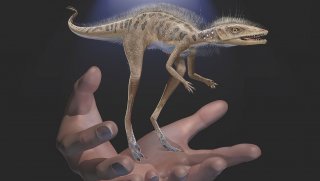Study This Picture: This Ancient Relative of Giant Dinosaurs Was Only 4 Inches Tall
More often than not, dinosaurs are thought to be intimidating giant creatures, but new research is putting forth interesting evidence that they likely started out tiny.
More often than not, dinosaurs are thought to be intimidating giant creatures, but new research is putting forth interesting evidence that they likely started out tiny.
Standing only about four inches tall, Kongonaphon kely, or “tiny bug slayer,” could be one of the last common ancestors of all dinosaurs and pterosaurs, an extinct flying reptile, 237 million years ago, according to a study published in the journal Proceedings of the National Academy of Sciences.
“There’s a general perception of dinosaurs as being giants,” Christian Kammerer, a research curator in paleontology at the North Carolina Museum of Natural Sciences, said in a press release.
“But this new animal is very close to the divergence of dinosaurs and pterosaurs, and it’s shockingly small.”
The diminutive fossil was first discovered in 1998 encased in sandstone at a site in Madagascar. The team of scientists and students, led by American Museum of Natural History Frick Curator of Fossil Mammals John Flynn, collected hundreds of fossils from the site over the years, which partly explains why it took so long for them to study this particular fossil.
“This fossil site in southwestern Madagascar from a poorly known time interval globally has produced some amazing fossils, and this tiny specimen was jumbled in among the hundreds we’ve collected from the site over the years,” Flynn said in a statement.
“It took some time before we could focus on these bones, but once we did, it was clear we had something unique and worth a closer look. This is a great case for why field discoveries—combined with modern technology to analyze the fossils recovered—is still so important.”
By studying Kongonaphon kely’s tiny pointed teeth, it was determined that this creature lived on a diet of hard-shelled insects. Examination of a small slice of the thigh bone helped researchers conclude that the tiny creature was not a baby, but a nearly full-grown adult.
Dinosaurs and pterosaurs both belong to the group Ornithodira, but their origins are still murky because few specimens from near the root of this lineage have been found. Popular scientific thought points toward the likelihood that dinosaurs’ body size remained similar to the earliest ornithodirans and archosaurs, a larger reptile group that includes birds, crocodilians and non-avian dinosaurs, before eventually growing to gigantic proportions.
“Recent discoveries like Kongonaphon have given us a much better understanding of the early evolution of ornithodirans,” Kammerer said.
“Analyzing changes in body size throughout archosaur evolution, we found compelling evidence that it decreased sharply early in the history of the dinosaur-pterosaur lineage.”
Ethen Kim Lieser is a Minneapolis-based Science and Tech Editor who has held posts at Google, The Korea Herald, Lincoln Journal Star, AsianWeek and Arirang TV. Follow or contact him on LinkedIn.

